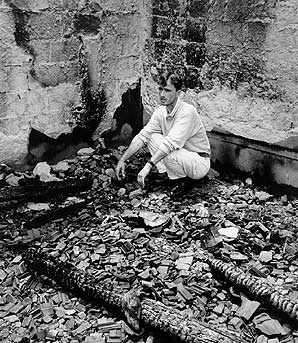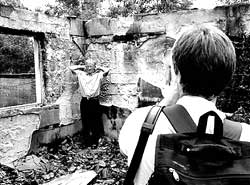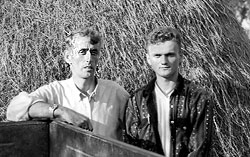From Prison to War | "Her Face Tortures Me" | Justice for All? | We Need Justice
The Massacre
Editors' Note: The names of victims and perpetrators in this report are changed in some cases to conceal their identities.
When the sun rose above the western Kosovo village of Cuska (pronounced CHOOSH kuh) on May 14, 1999, it was one of those humid, airless mornings that warns of a scorching day ahead. Dragan, a young Serbian militiaman, was agitated. He had been crouching in a grassy field since the previous day when he and dozens of other fighters were ordered to Cuska's outskirts and told to prepare to attack the ethnic Albanian village. Dragan says he hated these expectant moments that delayed the adrenaline rush of combat. He furtively smoked cigarettes, exchanged lewd jokes about the Albanians, and contemplated death - preferably someone else's.
"We waited all night for the signal to attack," he says, his thin face staring off at a distant scene. "It was nerve-wracking. ... The only way to forget about the blood and death is to treat it like a football game. And the only thing is to win the game."
"At dawn we finally got the go-ahead."
 |
|
|
A resident of Cuska visits the house where his father and other relatives were killed and incinerated. This man fled to the forest during the attack. He returned to bury the remains of 35 relatives and neighbors. (Photo: Stephen Smith) |
The first fired shots by Dragan and his comrades startled Lule, a 27-year-old Albanian woman who was dozing in her father's house in the center of Cuska. "I ran outside in my pajamas," she recalls. "I saw the men of our village running. I also saw smoke and flames. My neighbors said the Serbs were killing and burning, ... so I woke my parents and my uncle and the children."
"The soldiers had face paint, and some wore bandannas for masks," recalls Akif, Lule's uncle. "They were wearing a mixture of uniforms - some were police officers' uniforms, and some were the Yugoslav army's."
Some Albanian men managed to flee to nearby woods. Others were shot as they tried to escape. But many families were trapped. The militiamen quickly seized Lule's father, her uncle Akif, and her cousin.
The village of 200 houses and some 500-700 people (some Albanians had fled earlier in the war) was an easy target for the 100-or-so Serbian fighters present on May 14. The Albanian inhabitants could not have known that the early-morning attack was part of a broad assault on Cuska and two neighboring villages that had been planned days before by Serbian police and military commanders and that was carried out by some of Serbia's most elite units as well as its notorious militia gangs.
Serbian police and military commanders gave each of the six or seven fighting units a set of coordinates and a sector in the village to attack and "cleanse" according to Dragan. "When we went into the village it was undefended. We went house to house, clearing people out," he says. "We concentrated on killing rebels from the Kosovo Liberation Army (KLA). If we decided a guy was KLA, we often executed him on the spot."
"They took us to the village cemetery," says Akif, the wiry, 57-year-old Albanian farmer. "They separated the men from the women. The men they thought could fight. Then they started burning houses and shooting at people's feet to scare them."
 |
|
|
An ethnic Albanian resident of Cuska, Akif, demonstrates how he and 11 others were lined up and shot by Serb militia members. The hous e was burned but this man survived. A human rights investigator takes his photo. (Photo: Stephen Smith) |
Akif and his neighbors recognized some of the gunmen from their previous patrols in the village, when the Serbs rolled into Cuska looking for KLA fighters and menacing the villagers. But on those earlier visits the Serbs assured Cuska's residents that if they worked their land and lived peacefully, they'd be safe. May 14 was different.
"We were rough, even with kids or women," says Dusan, another Serbian fighter who took part in the attack on Cuska. "At one house an Albanian came out with bread and salt, which is a traditional Serbian way to welcome guests. We were insulted. So one of our guys hit the Albanian's wife with his rifle and then kicked the guy's child. Then that Albanian guy was taken away."
Akif was rounded up with some of his neighbors. "They divided us men into three groups and took us away. There were 12 of us in my group. They took us inside a neighbor's house and lined us against the living-room wall. They cursed us, then demanded more money. But we had already given them all the money we had."
Dragan was one of the Serbian fighters who led Akif and the others into the house. "We took 11 or 12 men. We concluded that some of them were KLA. ... You know the way we got them to talk, interrogation -- fists and a rifle butt to the head. Cut them with a knife so they'd confess something."
"The soldier came to the door," Akif says slowly, "and he said, 'In the name of Serbia you will all be executed.' And then he opened fire."
 |
|
|
Two men from Cuska who survived the May 14 attack on the farming village. Both lost fathers or brothers in the massacre. (Photo: Stephen Smith) |
A bullet ripped into Akif's thigh, but he was saved by the bodies of his brother Halil, and a neighbor. Before the killers left they tossed a cushion soaked with gasoline into the room where Akif lay hidden by the bodies of his family members. Dragan says the fire was meant to destroy the evidence, especially the bodies.
Remarkably, Akif escaped. "The door outside was on fire. Fortunately there was a window," Akif says. "I jumped from the window and ran bleeding into a grassy field and that's where I hid." None of the other men escaped the house alive.
Two other groups of men from the village were forced into separate houses, gunned down, and set on fire. In all, 41 men died in Cuska on May 14, ages 19 to 69. That same morning, Serbian security forces attacked two adjacent villages, Pavlan and Zahac, driving out the women, children, and elderly, and killing a total of 72 people. One young woman was kidnapped and never seen again.